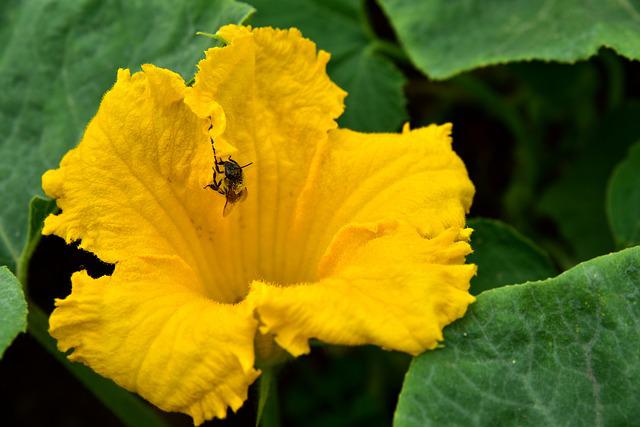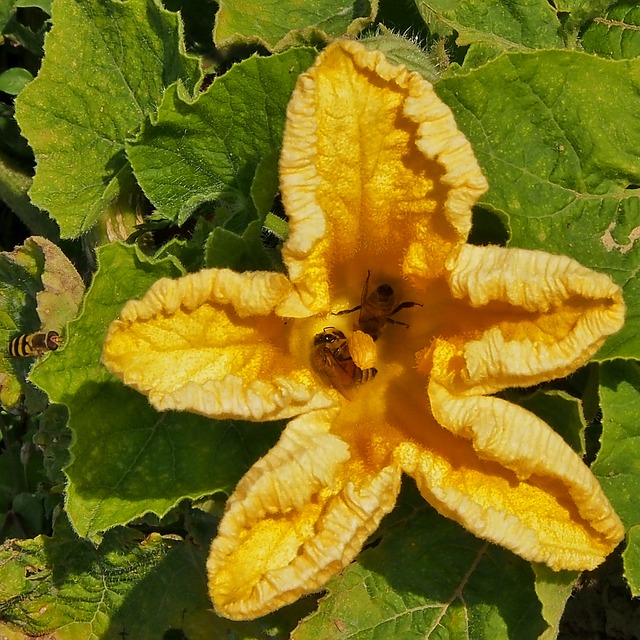Are Pumpkins Self-Pollinating?

The straightforward answer is no. In some cases, you or bees are needed to pollinate them. Male flowers produce nectar and pollen, while females have more nectar but no pollen. In this article, we’ll outline the process of pumpkin pollination. Keep reading!
Table of Contents
Details About Pollination
Many types of vegetable crops need to be pollinated by insects. Other vegetable crops that need pollination by insects are called “seed-only” crops. Vegetable species grown for the seed have very different pollination needs. This depends on whether a plant can pollinate itself or needs to be pollinated by another plant to set seeds.
Plants like pumpkin, squash, and zucchini have male and female flowers. Most of the time, there are more male flowers than female flowers. Male flowers have five anthers. The male flowers’ stamens have joined together to form a column in the middle. The large, round ovary at the bottom of the female flowers makes them easy to spot. A three-lobed stigma is inside the female flower. The female flowers make more nectar than the male flowers, but the male flowers’ nectar has more sugar. The number of male and female flowers depends on the temperature, the length of the day, how many fruits have already been set, and the time of year. Usually, both male and female flowers are only open for one day. After that, both male and female flowers that haven’t been pollinated enough will fall off.
Process of Pollination by Bees
Bees go to male flowers where big, sticky granules of pollen stick to them. Then they move on to the heavenly nectar made by the females, and the transfer is complete. Since the nectaries are all around the base of the flower, bees have to climb to the bottom of the flower, past the stigma or anthers, to get nectar. Pollinators working harder makes the fruit better. Even though the pumpkin plants have both male and female flowers, pollination doesn’t seem to be happening for a number of reasons. Maybe pesticides with a wide range of effects were used nearby, or perhaps the rain or heat kept the bees inside. Either way, you may have to pollinate pumpkins by hand in the future if no bees are pollinating.
Honey bees and many other insects like to visit the flowers. Several bee visits usually cause pollination, and the number of seeds in the fruit also goes up as the number of bee visits goes up. Some types of plants will pollinate each other, so they should be kept apart if you want to get seeds from them. Honey bee stocking rates are recommended to be between one and eight hives per hectare. It might be helpful to keep track of how many female flowers set fruit in different parts of a field to see if there are enough beehives.
Insects are needed to move a lot of pollen around to fertilize the many ovules in the female flowers. Pollinators that are active in the morning when pollen is released are the ones that do the best job. Most types of flowers open in the morning and close by or in the early afternoon.
For a female flower to make a fruit that can be sold, it needs to get a lot of pollen. Cross-pollination also makes the fruits themselves bigger.
Best Time to Pollinate
Pumpkins and other Cucurbits are monoecious, which means that each plant has both male and female flowers. During those golden hours, the best time to pollinate is when both kinds of flowers are open. Even though both male and female flowers can bloom simultaneously on the same plant, you’re more likely to get more pollination opportunities if you plant more than one of the same gourd. This is because more male flowers will be open at a certain time to pollinate the female flowers.
About 50 to 55 days after your seeds sprout, the first yellow flowers with open throats will show up. These are the male blooms, also called “staminate.” They usually start to bloom a week or two before the female, or pistillate, flowers. And, unlike the females, they don’t have a tiny baby, or ovary, at the bottom of the stem-like the females do.
Pollen from the male flower’s stamen must be moved to every part of the female flower’s pistil so that the baby ovary can grow into mature fruit.
But what if you don’t have many bees in your outdoor garden, you’re growing gourds in a greenhouse or another indoor space that bees can’t get to, or it rains on the day when both male and female flowers open, and the bees aren’t out and about? Hand pollination helps!

How to Pollinate Pumpkin Seeds by Hand
- Find a male flower first. This is the easiest way to do it. The pollen should stick to the stamen and make it look fuzzy.
- Pull back the petals until you can see the stamen. Bring the stamen over to the pistil of a female flower.
- Rub the male’s stamen over each segment of the female’s pistil until each segment is covered with sticky pollen.
- You can also get yellow pollen from the male flower with a paintbrush or cotton swab.
- Then, carefully spread the pollen over the pistil of the female flower.
- Gently seal the female flower by pressing the petals together and covering the pistil when you’re done. This will keep bugs from landing there and taking the pollen to other flowers.
- If enough pollen gets to the female flower, the petals will dry up and fall off, and the tiny ovary will grow into a fat pumpkin.
